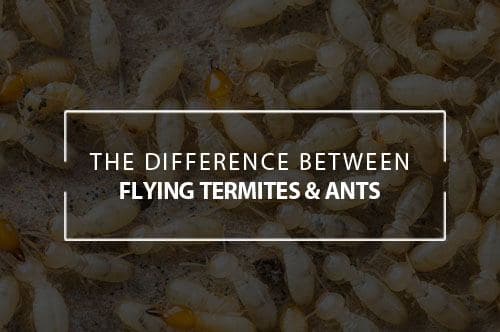“Flying ants or swarming termites?” is an expression used many times in commercials by pest control companies. Most people aren’t going to examine insects closely to determine whether they meet the standards as ants or termites, there are some distinctive differences between the two.

Ants have crooked antennae, while the termite sports straight ones. One of the more prominent differences between the two is their bodies. Termites have straight waists that disguise the separation of parts, but ants have three distinctive body sections. The ants will have two eyes, one on each side of the head; Termites won’t have any and are completely blind. Flying termites have four wings that are all the same size, as the ant has two pairs of different sizes.
The termites that fly are those that reproduce. They look for a place to begin a new colony that is independent of the one they left. Similarly, ants that fly are mating insects which usually only live for a short time, especially the males.
Flying ants or swarming termites are both referred to as alates, which simply means that they are at the mature stage of their lives. Termites swarm when the existing colony has all the members that it needs. This can cause the population to become stressed.
Flying ants are a nuisance for a short time, while termites that fly become the real problem after they locate a place to begin their families. The stress for you comes when they establish a home within yours. When you identify flying termites, contact your local pest control company to evaluate if they are leaving your domain or coming into it so proper protective and extermination measures can be promptly taken.
Termites recycle waste by consuming waste such as dead wood, feces, and plants.There are two groups of termites: higher termites and lower termites. The higher termites consumer a different variety of materials, feces, humus, grass, and leaves. As the lower termites consume mostly on wood, it can be difficult to digest; They prefer to consume fungus-infected wood which is easier to digest that has more protein. While termites eat only specific material, ants eat just about anything. There are many different ant species; Most love sweets, while other ants like fungus. Food is a necessity to ants that requires a diet of proteins, carbs, and lipids.
There are three types of termites: drywood, dampwood, and subterranean. Drywood termites are the most destructive to homes as some like to spend the rest of their lives inside of dry wood. As these termites have wings they like to be in higher places of the home or building. You can find these type of termites in south-western states. Dampwood termites craves for wet or decaying wood. These type of termites aim for older homes with unseen damage to the home. You’ll see dampwood termites along the west coast. Subterranean termites come in colonies of millions that are known for how quickly they can consume wood. They’ll eat anything that consists of cellulose fibers and any type of wood. The subterranean termites can be found all throughout the U.S. but more commonly in the southern half.
Ants of all varieties make their homes in many different places. In the arid desert, we find ants nesting in mounds of sand, and other desert vegetation. Some ant colonies can also be found is damp or rotting wood. If you have an ant problem, you will probably find that the invaders all live in one central colony or a few colonies. Locating the colony can be tricky which is why many people elect to hire a professional termite or pest control company.
How To Prevent Termite Swarms In Your Home If you own property in Arizona, you…
Black Widow Spiders Prevention Tips Have you spotted these eight-legged demons in your Arizona home?…
Ways To Keep Bees Away From Your Home For many of us, bees are harmless…
Roaches In My Microwave: What Can I Do? How would you react if you found…
Why Are There So Many Spiders In My Garage? Have you ever seen spiders in…
How To Get Rid Of Scorpion Infestations Naturally Scorpion infestations are a common problem for…